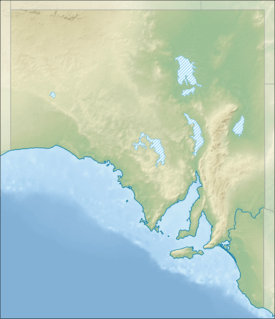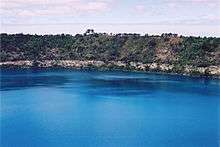Blue Lake (South Australia)
| Blue Lake | |
|---|---|
 Panorama of the Blue Lake in mid-December. | |
 Blue Lake Location in South Australia | |
| Location | Mount Gambier, South Australia |
| Coordinates | 37°50′48″S 140°46′41″E / 37.84667°S 140.77806°ECoordinates: 37°50′48″S 140°46′41″E / 37.84667°S 140.77806°E |
| Type | Monomictic crater lake |
| Basin countries | Australia |
| Max. length | 1,087 m (3,566 ft) |
| Max. width | 657 m (2,156 ft) |
| Surface area | 70 ha (170 acres) |
| Average depth | 72 m (236 ft) |
| Max. depth | 77 m (253 ft) |
| Water volume | none |
| Residence time | 3.45 years |
| Shore length1 | None |
| Surface elevation | approx. 20 m (66 ft) |
| Islands | None |
| Settlements | None |
| 1 Shore length is not a well-defined measure. | |
The Blue Lake is a large monomictic crater lake located in a dormant volcanic maar associated with the Mount Gambier maar complex. The lake is situated near Mount Gambier in the Limestone Coast region of South Australia and is one of four crater lakes on Mount Gambier maar. Of the four lakes, only two remain, as the other two (Leg of Mutton and Brown) have dried up over the past 30 to 40 years as the water table has dropped.
Conflicting dates have been estimated for its last eruption, of 4,300 years ago,[1] of 28,000 years ago,[2] and, most recently, a little before 6,000 years ago.[2][3] If the youngest date is correct, this could be the most recent volcanic eruption on the Australian mainland.
Blue Lake is thought to be of an average depth of 72 metres (236 ft), but in places reaches 75 metres (246 ft) deep. The crater rim measures 1,200 metres (3,900 ft) by 824 metres (2,703 ft), however, the lake itself measures 1,087 metres (3,566 ft) by 657 metres (2,156 ft). The bottom of the lake is 30 metres (98 ft) below the level of the main street of the nearby town. The Blue Lake supplies the town with drinking water, providing approximately 3,500 megalitres (920,000×103 US gal; 770,000×103 imp gal) per year from its 36,000 ML (9,500,000×103 US gal; 7,900,000×103 imp gal) store.
Studies
Bathymetric surveys located the deepest point in the lake at 77 metres (253 ft) in 1967.[4] Major diving exploration of the lake first occurred in 1985. Cave diver Peter Horne conducted temperature and visibility studies and made discoveries of a fresh water sponge species and other invertebrates.[4] This exploration also discovered "The Stromatolite Field", a collection of hollow rock formations that are found along the north-eastern perimeter down to a depth of 40 metres (130 ft).[4] In 2008, permission was granted by SA Water for another diving exploration of the central and deepest parts of the lake.[4] On this dive core samples from the calcite-silt covered lake bed were collected where water temperature drops to 14 °C (57 °F).
Mechanism of colour change
During December to March, the lake turns to a vibrant cobalt blue colour, returning to a colder steel grey colour for April to November. The exact cause of this phenomenon is still a matter of conjecture, but it is generally considered likely that it revolves around the warming of the surface layers of the lake during the summer months to around 20 °C (68 °F), causing calcium carbonate to precipitate out of solution and enabling micro-crystallites of calcium carbonate to form. This results in scatter of the blue wavelengths of sunlight. During winter the lake becomes well mixed, and recent research indicates that during this phase of the colour cycle the lake is somewhat murkier due to the redistribution of tannins and calcium carbonate particles throughout the lake. Solar elevation has also been found to influence the perceived colour of the lake. The movement of planktonic life-forms within the lake during the seasons and during the day may additionally play a part in the colour change.
Gordon's Leap
In July 1865 Adam Lindsay Gordon performed the daring riding feat known as Gordon’s Leap on the edge of the Blue Lake. A commemorative obelisk erected there has an inscription which reads:[5]
This obelisk was erected as a memorial to the famous Australian poet. From near this spot in July, 1865 Gordon made his famed leap on horseback over an old post and rail guard fence onto a narrow ledge overlooking the Blue Lake and jumped back again onto the roadway. The foundation stone of the Gordon Memorial Obelisk was laid on 8th July 1887
Gallery
-

The Blue Lake in early March.
-

The Blue Lake in early March.
-

The Blue Lake in early March.
-

Approximately 4 m (13 ft) above the lake's surface.
-

The lake in early March with the original pumping station in the foreground.
-

The Adam Lindsay Gordon obelisk at the Blue Lake.
See also
Notes
- ↑ "Volcanoes & Earthquakes in SE Australia". University of Western Australia. Retrieved 2008-05-07.
- 1 2 Grimes, Ken (2013). "The Ages of Our Volcanoes" (PDF). Retrieved 2014-08-05.
- ↑ Gouramanis, Chris; Wilkins, Daniel; De Deckker, Patrick (2010). "6000 years of environmental changes recorded in Blue Lake, South Australia, based on ostracod ecology and valve chemistry". Palaeogeography, Palaeoclimatology, Palaeoecology. 297: 223. doi:10.1016/j.palaeo.2010.08.005.
- 1 2 3 4 Harris, Richard (July–September 2008). "The big blue". Australian Geographic. 91: 34.
- ↑ "Traditional Featured Poet - Adam Lindsay Gordon". Bush Song Newsletter. Archived from the original on 19 August 2011. Retrieved 30 May 2011.
References
- Sheard, M.J. (1978) Geological History of the Mount Gambier Volcanic Complex, Southeast South Australia. Transcript from Royal Society of South Australia 102(5), Aug. 1978
- Telfer, A. (2000) Identification of processes regulating the colour and colour change in an oligotrophic, hardwater, groundwater-fed lake, Blue Lake, Mount Gambier, South Australia. Lakes and Reservoirs: Research and Management. 5 161-176.
- Turoczy, N.J. (2002) Calcium chemistry of Blue Lake, Mt Gambier, Australia, and relevance to remarkable seasonal colour changes. Archiv für Hydrobiologia. 156 (1) 1-9.
- Emeny, J., Turner, G., Turoczy, N.J. and Stagnitti, F. (2006) The influence of weather and solar elevation on perceived colour of Blue Lake, Mount Gambier, South Australia. Transactions of the Royal Society of South Australia. 130(1) 101-108.